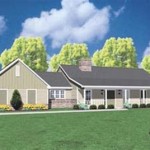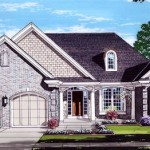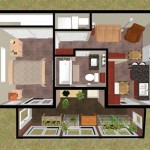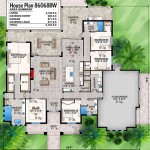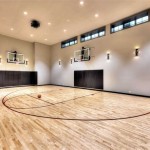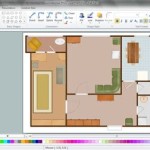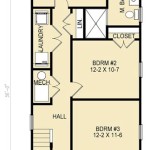House Plans: 1500 to 1700 Square Feet
Selecting the appropriate house plan is a crucial step in the home-building process. Size is a primary consideration, and plans ranging from 1500 to 1700 square feet offer a balanced approach. This size range provides a comfortable living space for small to medium-sized families, couples, or individuals who desire extra room for hobbies, guests, or home offices without the expansive maintenance and cost associated with larger residences.
House plans within this range typically incorporate three bedrooms, two bathrooms, a living area, a kitchen, and a dining space. However, the specific layout and arrangement can vary widely depending on the design style, orientation of the lot, and the homeowner's preferences. Understanding the nuances of plans in this square footage range is essential for making an informed decision that aligns with individual needs and lifestyles.
Key Considerations for 1500 to 1700 Square Foot House Plans
Several key factors should be evaluated when considering house plans within the 1500 to 1700 square foot range. These factors include the floor plan layout, the architectural style, and energy efficiency features. Careful consideration of these elements will contribute to a functional, aesthetically pleasing, and cost-effective home.
Floor Plan Layout: The floor plan is the blueprint for the interior space and dictates how different rooms connect and flow. For 1500-1700 square foot homes, efficient space utilization is paramount. Two common layout options are the open concept and the traditional, compartmentalized design. Open-concept plans combine the living room, dining area, and kitchen into one large, multi-functional space, promoting social interaction and creating an illusion of greater spaciousness. Traditional layouts, on the other hand, separate rooms with walls, providing more privacy and defined areas for specific activities. The choice between these layouts depends on the homeowner's lifestyle and preferences for social interaction versus individual privacy. Another consideration is the placement of bedrooms and bathrooms. Popular choices include split bedroom plans, which position the master suite on one side of the house and the secondary bedrooms on the other, creating a buffer and increased privacy for the homeowners. The number of bathrooms is also crucial. While two bathrooms are common in this size range, some plans may offer a powder room for guests or an additional full bathroom depending on the number of bedrooms and overall design.
Architectural Style: The architectural style of a house plan refers to its external design features, including the roofline, window placement, and overall aesthetic appeal. Popular styles for homes in the 1500 to 1700 square foot range include ranch, contemporary, craftsman, and farmhouse designs. Ranch-style houses are characterized by their single-story layout, low-pitched roofs, and horizontal orientation. They offer ease of accessibility and are well-suited for individuals with mobility limitations. Contemporary style homes often feature clean lines, large windows, and a focus on natural light. They may incorporate sustainable materials and energy-efficient design elements. Craftsman homes are known for their detailed woodwork, gabled roofs, and covered front porches. They offer a classic and charming aesthetic. Farmhouse style homes often incorporate rustic elements, such as shiplap siding, exposed beams, and large kitchens. The architectural style of a house plan should complement the surrounding environment and reflect the homeowner's personal taste. External factors like neighborhood covenants and local climate conditions can influence the selection of an architectural style.
Energy Efficiency: Energy efficiency is an increasingly important consideration in home building. House plans in the 1500 to 1700 square foot range can incorporate various energy-saving features to reduce utility bills and minimize environmental impact. These features may include proper insulation in walls and ceilings, energy-efficient windows and doors, high-efficiency HVAC systems, and solar panel integration. The orientation of the house on the lot can also affect energy efficiency. Positioning the house to maximize sunlight exposure in the winter and minimize it in the summer can reduce heating and cooling costs. Water conservation measures, such as low-flow plumbing fixtures and rainwater harvesting systems, can further enhance the sustainability of the home. Selecting appliances with high Energy Star ratings is also a simple yet effective way to reduce energy consumption. Addressing energy efficiency during the design phase can result in significant long-term savings and a more comfortable living environment.
Common Design Elements in 1500 to 1700 Square Foot House Plans
Certain design elements are frequently observed in house plans within the 1500 to 1700 square foot range, optimizing space utilization and enhancing functionality. These elements include open living spaces, strategically placed storage solutions, and flexible room usage.
Open Living Spaces: Open living spaces are a popular feature in modern house plans, particularly in smaller homes. Combining the living room, dining area, and kitchen into one unified space creates a sense of spaciousness and promotes social interaction. This design also allows for better natural light penetration, reducing the need for artificial lighting. When designing an open living space, it is important to consider the flow of traffic and create distinct zones for different activities. Furniture placement, varying floor coverings, and subtle changes in ceiling height can help define these zones without the need for walls. Adequate ventilation is also important to prevent cooking odors from permeating the entire living space. The use of a kitchen island or peninsula can provide additional counter space and serve as a natural divider between the kitchen and the living area.
Strategic Storage Solutions: Storage space is a premium in any home, and efficient storage solutions are crucial in 1500 to 1700 square foot houses. Incorporating built-in shelving, closets, and cabinets can maximize storage capacity without sacrificing valuable floor space. Under-stair storage, attic storage, and garage storage are often overlooked but can provide significant additional storage. In bedrooms, walk-in closets or built-in wardrobes can help keep clothing and accessories organized. In the kitchen, pull-out drawers, pantry organizers, and vertical storage solutions can maximize space utilization. Multi-functional furniture, such as storage ottomans or bed frames with drawers, can also help reduce clutter and provide additional storage. Careful planning for storage space during the design phase can prevent the accumulation of clutter and promote a more organized and functional living environment.
Flexible Room Usage: Flexible room usage is the concept of designing rooms that can serve multiple purposes, adapting to the changing needs of the homeowner. In a 1500 to 1700 square foot home, this can be particularly beneficial. A spare bedroom can double as a home office or a guest room. A formal dining room can be converted into a library or a playroom. Selecting furniture that is easily movable and adaptable can further enhance the flexibility of a room. For example, a sofa bed can transform a home office into a guest room. A dining table with leaves can be extended for larger gatherings or reduced in size for everyday meals. When designing for flexible room usage, it is important to consider the lighting and electrical needs of each potential function. Ample power outlets and appropriate lighting fixtures should be installed to accommodate various activities. Flexible room usage promotes efficiency and ensures that every square foot of the home is utilized to its fullest potential.
Cost Considerations for Building a 1500 to 1700 Square Foot Home
The cost of building a house within the 1500 to 1700 square foot range can vary significantly depending on several factors, including location, materials, labor costs, and the complexity of the design. Understanding these cost factors is essential for creating a realistic budget and avoiding unexpected expenses.
Location: The location of the building site has a significant impact on construction costs. Land prices vary widely depending on the proximity to urban areas, the availability of amenities, and the desirability of the neighborhood. Building permits and impact fees also differ by location. Labor costs tend to be higher in urban areas with a higher cost of living. In addition to these direct costs, location can also affect the cost of materials. Transportation costs for materials can be higher in remote areas, and certain materials may be more readily available in some regions than others. Before finalizing a house plan, it is important to research local building codes, zoning regulations, and permit requirements to ensure compliance and avoid costly delays.
Materials: The choice of building materials significantly impacts the overall cost of construction. High-end materials, such as hardwood flooring, granite countertops, and custom cabinetry, will increase costs, while more budget-friendly options, such as laminate flooring, laminate countertops, and stock cabinetry, can help reduce expenses. The type of exterior siding, roofing material, and window construction also affect the cost. Sustainable materials, such as bamboo flooring, recycled content insulation, and energy-efficient windows, may have a higher upfront cost but can result in long-term savings on energy bills. Selecting materials that are durable, low-maintenance, and aesthetically pleasing is crucial for creating a comfortable and valuable home. Obtaining multiple quotes from different suppliers can help ensure that the best prices are obtained for the chosen materials.
Labor Costs: Labor costs typically account for a significant portion of the total construction cost. The cost of labor varies depending on the region, the skill level of the tradespeople, and the complexity of the project. General contractors typically charge a percentage of the total construction cost to oversee the project and manage subcontractors. It is important to obtain multiple bids from different contractors and carefully review their qualifications, experience, and references. Subcontractors, such as plumbers, electricians, and carpenters, also charge hourly rates or fixed fees for their services. Clearly defining the scope of work and the payment schedule in the contract can help prevent misunderstandings and disputes. Paying prevailing wages and ensuring that all workers are properly licensed and insured is also important for protecting the homeowner from liability.

House Plan 98613 Ranch Style With 1700 Sq Ft 3 Bed 2 Bath

Ranch Style House Plan 3 Beds 2 Baths 1700 Sq Ft 44 104 Houseplans Com

1 501 To 700 Sq Ft Ranch Floor Plans Advanced Systems Homes

19 Best 1700 Sq Ft House Plans Ideas Floor Small

Traditional Plan 1 700 Square Feet 4 Bedrooms 2 Bathrooms 8768 00031

Franklin House Plan 1700 Square Feet

House Plans Of Two Units 1500 To 2000 Sq Ft Autocad File Free

2 Bed 1700 Square Foot Rustic One Story House Plan With Vaulted Open Floor 135221gra Architectural Designs Plans

French Country Plan 1 700 Square Feet 3 Bedrooms 2 Bathrooms 041 00031

Suncrest Ii House Plan 1700 Heated Square Feet

